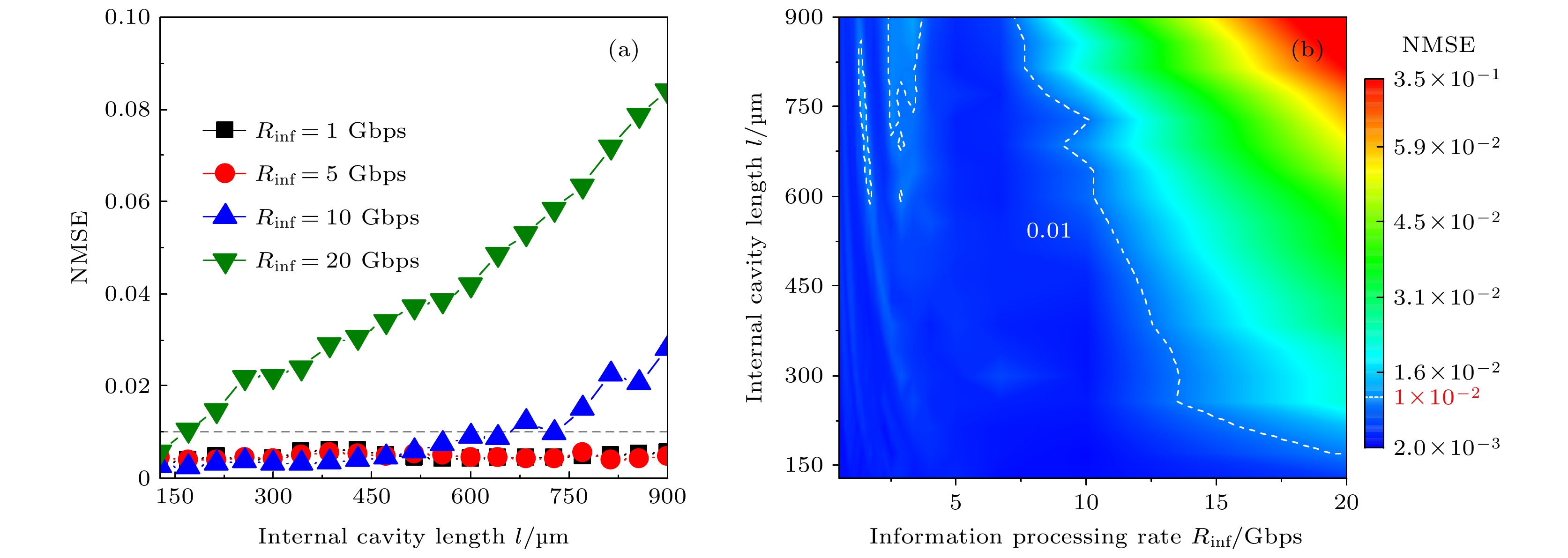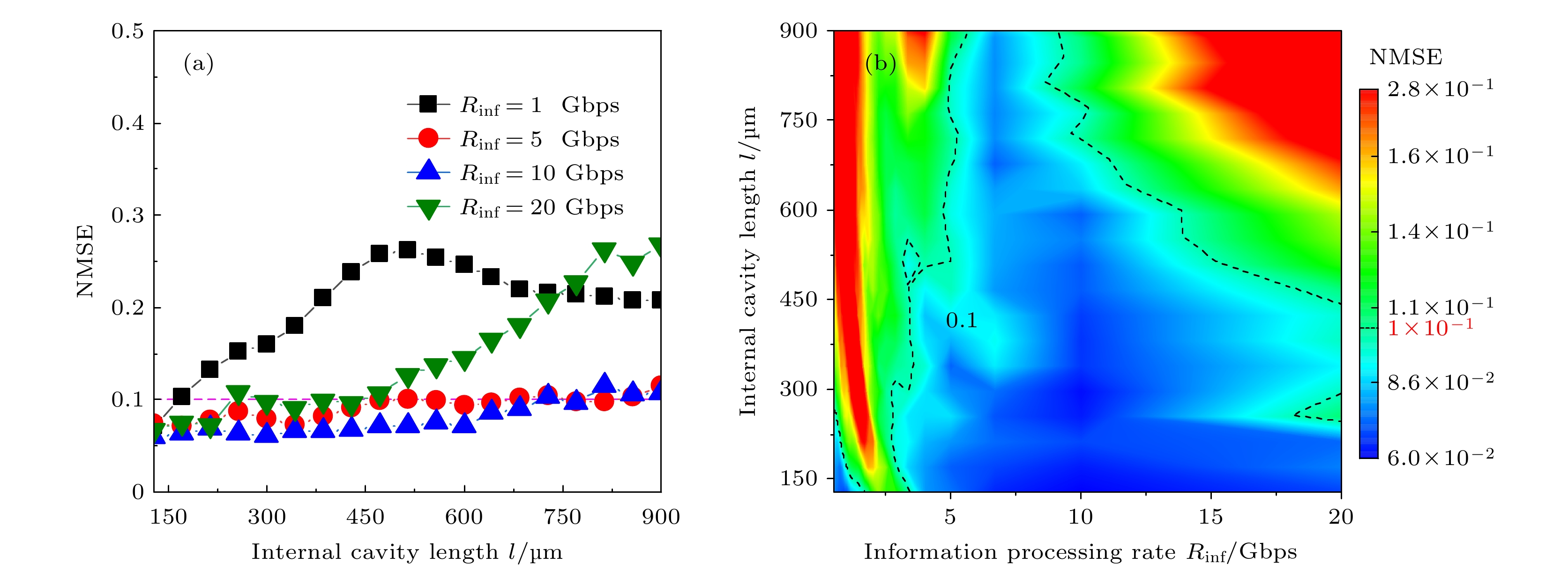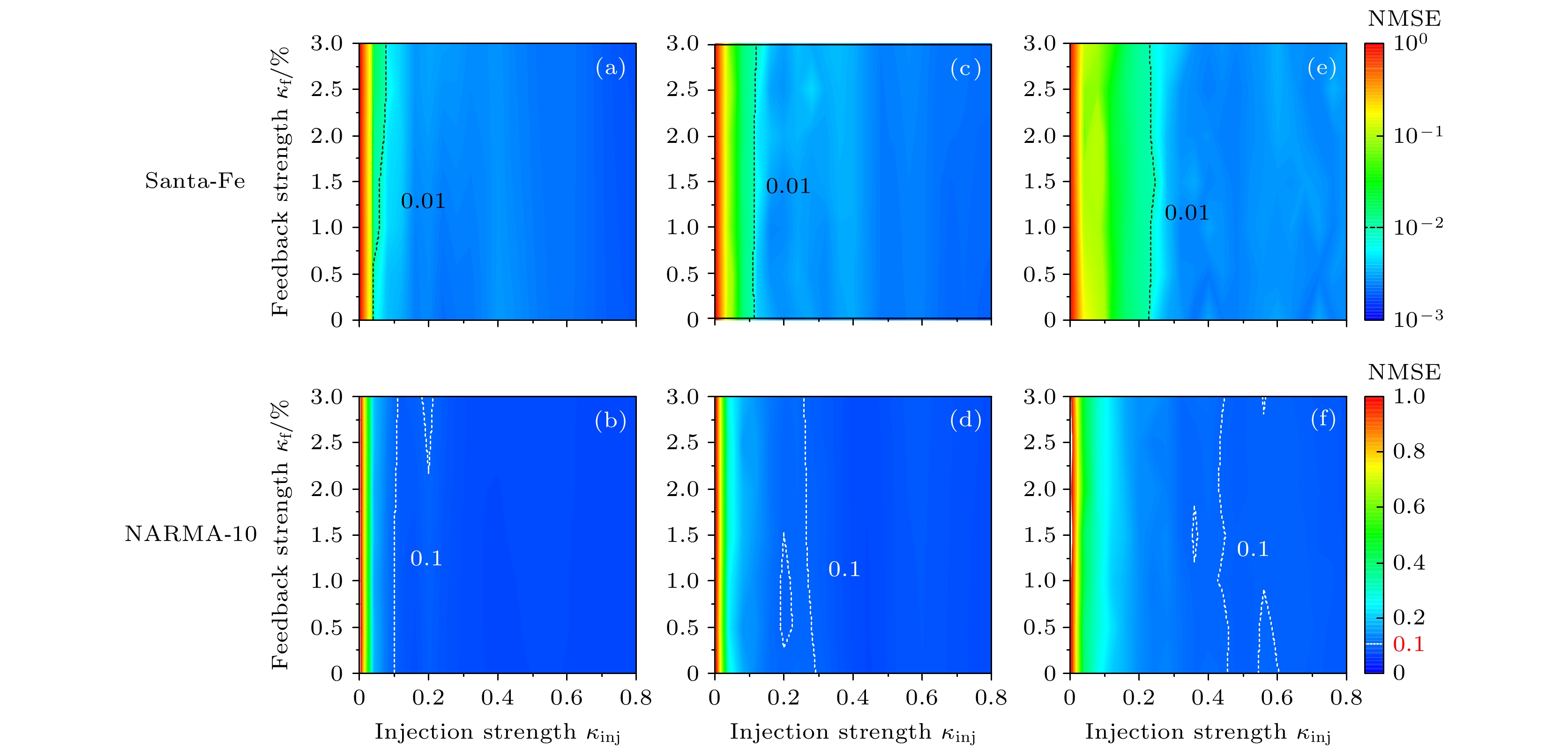-
随着高速信息时代的来临及信息量的爆炸式增长, 对信息处理速度提出了更高的要求, 光子储备池计算系统成为了解决方案之一. 短光子寿命易于提升光子储备池计算系统的响应速度而有助于实现更高速率的信息处理. 激光器内腔长度会影响光子寿命, 同时还影响了激光器输出进入不同动力学状态时所需的相关参数值. 因此, 本文研究了不同内腔长度(120—900 μm)对基于分布式反馈激光器的储备池计算系统性能及相关参数空间的影响. 结果表明, 当内腔长度在120—171 μm范围内, 系统可低误差处理20 Gbps速率的信息; 内腔长度介于120—380 μm之间时、较大的频率失谐及少量虚拟节点数(50), 仍可使系统具有良好的预测效果; 内腔长度较短时, 反馈强度与注入强度组成的高性能参数空间可提高22%—40%.With the advent of the high-speed information age and the explosive growth of the information, higher requirements have been placed on the information processing speed. In recent years, the delay-based reservoir computing (RC) systems have been extensively investigated. Meanwhile, the information processing rate is improved mainly around the replacement of nonlinear nodes in the system. Nevertheless, as the most commonly used distributed feedback semiconductor (DFB) laser, many researchers only use ordinary commercial DFB products for research, and they have not noticed the improvement of RC performance caused by changes in internal parameters of laser. With the development of photonic integration technology, the processing technology of DFB turns more mature, so that the size of DFB can be fabricated in a range of 100 μm–1 mm when it still generates laser, and the photon lifetime of the laser will also change. The shorter photon lifetime in the laser leads to a faster dynamic response, which has the potential to process the information at a higher rate in the RC system. According to the laser rate equation (Lang-Kobayashi), changing the internal cavity length will affect the feedback strength, injection strength and other parameters required for the laser to enter into each dynamic state, which in turn affects the parameter space required for the RC system to exhibit high performance. According to this, we study the relationship between the internal cavity length (120 μm–900 μm) and the information processing rate of the RC system. In addition, the influences of different internal cavity lengths on the parameter space of the RC system are analyzed. The results show that when the internal cavity length is in a range from 120 μm to 171 μm, the system can achieve 20-Gbps low-error information processing. It is worth noting that when the internal cavity length decreases from 600 μm to 128 μm, the parameter space with better prediction performance of the RC system is greatly improved. When performing the Santa-Fe chaotic time series prediction task, the normalized mean square error (NMSE) is less than 0.01, and the parameter range of the injection strength is increased by about 22%. The range of parameter with NMSE no more than 0.1 is improved by nearly 40% for the 10th order nonlinear auto-regressive moving average (NARMA-10) task. When the number of virtual nodes is 50, the system can achieve a high-precision prediction for the above two tasks. This is of great significance for the practical development of the system.
-
Keywords:
- reservoir computing /
- internal cavity length /
- information processing /
- nonlinear dynamic system
[1] Lukosevicius M, Jaeger H 2009 Comput. Sci. Rev. 3 127
 Google Scholar
Google Scholar
[2] Maass W, Natschläger T, Markram H 2002 Neural Comput 14 2531
 Google Scholar
Google Scholar
[3] Jaeger H, Haas H 2004 Science 304 78
 Google Scholar
Google Scholar
[4] Sunada S, Uchida A 2021 Optica 8 1388
 Google Scholar
Google Scholar
[5] Nakajima M, Tanaka K, Hashimoto T 2021 Commun. Phys. 4 20
 Google Scholar
Google Scholar
[6] Pearlmutter B A 1995 IEEE Trans. Neural Networks 6 1212
 Google Scholar
Google Scholar
[7] Bishop C M 2006 (New York: Springer-Verlag)
[8] Appeltant L, Soriano M C, Van D S G, Danckaert J, Massar S, Dambre J, Schrauwen B, Mirasso C R, Fisher I 2011 Nat. Commun. 2 468
 Google Scholar
Google Scholar
[9] Haynes N D, Soriano M C, Rosin D P, Fischer I, Gauthier D J 2015 Phys. Rev. E 91 020801
 Google Scholar
Google Scholar
[10] Paquot Y, Duport F, Smerieri A, Dambre J, Schrauwen B, Haelterman M, Massar S 2012 Sci. Rep. 2 287
 Google Scholar
Google Scholar
[11] Du W, Li C H, Huang Y X, Zou J H, Luo L Z, Teng C H, Kuo H C, Wu J, Wang Z M 2022 IEEE Electron Device Lett. 43 406
 Google Scholar
Google Scholar
[12] Kanno K, Uchida A 2022 Sci. Rep. 12 3720
 Google Scholar
Google Scholar
[13] Soriano M C, Ortín S, Brunner D, Larger L, Mirasso C R, Fischer I, Pesquera L 2013 Opt. Express 21 12
 Google Scholar
Google Scholar
[14] Duport F, Schneider B, Smerieri A, Haelterman M, Massar S 2012 Opt. Express 20 22783
 Google Scholar
Google Scholar
[15] Genty G, Salmela L, Dudley J M, Brunner D, Kokhanovskiy, Kobtsev S, Turitsyn S K 2020 Nat. Photonics 15 91
 Google Scholar
Google Scholar
[16] 花飞, 方捻, 王陆唐 2019 物理学报 68 224205
 Google Scholar
Google Scholar
Hua F, Fang N, Wang L T 2019 Acta Phys. Sin. 68 224205
 Google Scholar
Google Scholar
[17] 刘奇, 李璞, 开超, 胡 春强, 蔡强, 张建国, 徐兵杰 2021 物理学报 70 154209
 Google Scholar
Google Scholar
Liu Q, Li P, Kai C, Hu C Q, Cai Q, Zhang J G, Xu B J 2021 Acta Phys. Sin. 70 154209
 Google Scholar
Google Scholar
[18] Argyris A, Schwind J, Fischer I 2021 Sci. Rep 11 6701
 Google Scholar
Google Scholar
[19] Tanaka G, Yamane T, Héroux J B, Nakane R, Kanazawa N, Takeda S, Numata H, Nakano D, Hirose A 2019 Neural Networks 115 100
 Google Scholar
Google Scholar
[20] Lugnan A, Katumba A, Laporte F, Freiberger M, Bienstman P 2020 APL Photonics 5 020901
 Google Scholar
Google Scholar
[21] Cai Q, Guo Y, Li P, Bogris A, Wang Y 2021 Photonics Res 9 14
 Google Scholar
Google Scholar
[22] Brunner D, Soriano M C, Mirasso C R, Fischer I 2013 Nat. Commun 4 1364
 Google Scholar
Google Scholar
[23] Nguimdo R M, Verschaffelt G, Danckaert J, Guy V D S 2015 IEEE Trans. Neural Networks Learn. Syst 26 3301
 Google Scholar
Google Scholar
[24] Vatin J, Rontani D, Sciamanna M 2018 Opt. Lett 43 4497
 Google Scholar
Google Scholar
[25] Nguimdo R M, Erneux T 2019 Opt. Lett 44 49
 Google Scholar
Google Scholar
[26] Bogris A, Mesaritakis C, Deligiannidis S, Li P 2020 IEEE J. Sel. Top. Quantum Electron 27 1
 Google Scholar
Google Scholar
[27] Guo X X, Xiang S Y, Zhang Y H, Lin L, Wen A J, Hao Y 2020 IEEE J. Sel. Top. Quantum Electron 26 1
 Google Scholar
Google Scholar
[28] Huang Y, Zhou P, Yang Y, Li N Q 2021 Opt. Lett 46 6035
 Google Scholar
Google Scholar
[29] Kuriki Y, Nakayama J, Takano K, Uchia A 2018 Opt. Express 26 5777
 Google Scholar
Google Scholar
[30] Wang D, Wang L, Zhao T, Gao H, Wang Y, Chen X, Wang A 2017 Opt. Express 25 10911
 Google Scholar
Google Scholar
[31] Argyris A, Bueno J, Fischer I 2018 Sci. Rep 8 8487
 Google Scholar
Google Scholar
[32] Hou Y S, Xia G Q, Yang W Y, Wang D, Jayaprasath E, Jiang Z F, Hu C X, Wu Z M 2018 Opt. Express 26 10211
 Google Scholar
Google Scholar
[33] Lang R, Kobayashi K 1980 IEEE J. Quantum Electron 16 347
 Google Scholar
Google Scholar
[34] Ohtsubo J 2017 Springer Series in Optical Sciences (USA)
[35] Berre M L, Ressayre E, Talleta A, Gibbs H M, Kaplan D L, Rose M H 1987 Phys. Rev. A 35 4020
 Google Scholar
Google Scholar
[36] Jaeger H 2002 Conference and Workshop on Neural Information Processing Systems Vancouver Canada, Nips December 9–14, 2002 p609
[37] Yue D Z, Wu Z M, Hou Y S, Hu C X, Xia G Q 2021 IEEE Photonics J 13 1
 Google Scholar
Google Scholar
[38] Estébanez I, Schwind J, Fischer I, Argyris A 2020 Nanophotonics 9 4163
 Google Scholar
Google Scholar
-
图 3 基于Santa-Fe混沌时间序列预测任务的 (a) 不同信息处理速率下内腔长度对处理效果的影响, (b) 内腔长度与信息处理速率参数空间中NMSEs的二维图. I = 1.05Ith, M = 50, κinj = 0.5, κf = 0.5%, Δv = 20 GHz
Fig. 3. Based on Santa-Fe chaotic time series prediction task: (a) The influence of internal cavity length on processing effect under different information processing rate; (b) two dimensional maps of NMSEs in parameter space of internal cavity length and information processing rate. I = 1.05Ith, M = 50, κinj = 0.5, κf = 0.5%, Δv = 20 GHz.
图 4 基于NARMA-10任务的 (a) 不同信息处理速率下内腔长度对处理效果的影响, (b) 在内腔长度与信息处理速率参数空间中NMSEs的二维图. I = 1.05Ith, M = 50, κinj = 0.5, κf = 0.5%, Δv = 20 GHz
Fig. 4. Based on NARMA-10 task: (a) The influence of internal cavity length on processing effect under different information processing rate; (b) two dimensional maps of NMSEs in parameter space of internal cavity length and information processing rate. I = 1.05Ith, M = 50, κinj = 0.5, κf = 0.5%, Δv = 20 GHz.
图 5 不同虚拟节点数下内腔长度对NMSE的影响 (a) Santa-Fe混沌时间序列预测任务; (b) NARMA-10任务. I = 1.05 Ith, M = 50, κinj = 0.5, κf = 1%, Δv = 20 GHz
Fig. 5. The influence of internal cavity length on NMSE under different numbers of virtual nodes: (a) Santa-Fe chaotic time series prediction task; (b) NARMA-10 task. I = 1.05 Ith, M = 50, κinj = 0.5, κf = 1%, Δv = 20 GHz.
图 6 在内腔长度与频率失谐参数空间中NMSEs的二维图 (a) Santa-Fe混沌时间序列预测任务; (b) NARMA-10任务. I = 1.05 Ith, M = 50, κinj = 0.5, κf = 0.5%
Fig. 6. Two dimensional maps of NMSEs in parameter space of internal cavity length and frequency detuning: (a) Santa-Fe chaotic time series prediction task; (b) NARMA-10 task. I = 1.05 Ith, M = 50, κinj = 0.5, κf = 0.5%.
图 7 不同内腔长度下注入强度和反馈强度对NMSE的影响 (a), (b) l = 128 μm; (c), (d) l = 300 μm; (e), (f) l = 600 μm. 从上到下: Santa-Fe混沌时间序列预测任务、NARMA-10任务. I = 1.05 Ith, M = 50, Δv = 20 GHz
Fig. 7. The influence of injection strength and feedback strength on NMSE under different internal cavity length: (a), (b) l = 128 μm; (c), (d) l = 300 μm; (e), (f) l = 600 μm. From top to bottom: Santa-Fe chaotic time series prediction task, NARMA-10 task. I = 1.05 Ith, M = 50, Δv = 20 GHz.
表 1 数值模拟中DFB的部分参数
Table 1. Partial parameters of DFB in numerical simulation.
符号 参数 参考值 α 线宽增强因子 4 g/ns–1 增益系数 1.2 × 10–5 N0 透明载流子数 1.5 × 108 ε/m3 增益饱和系数 5 × 10–23 τs/ns 载流子寿命 2 λ0/nm 波长 1550 D/ns–1 自发辐射噪声强度 30 Einj, 0 注入电场平均幅度 100 bbias 偏置项 0.5 -
[1] Lukosevicius M, Jaeger H 2009 Comput. Sci. Rev. 3 127
 Google Scholar
Google Scholar
[2] Maass W, Natschläger T, Markram H 2002 Neural Comput 14 2531
 Google Scholar
Google Scholar
[3] Jaeger H, Haas H 2004 Science 304 78
 Google Scholar
Google Scholar
[4] Sunada S, Uchida A 2021 Optica 8 1388
 Google Scholar
Google Scholar
[5] Nakajima M, Tanaka K, Hashimoto T 2021 Commun. Phys. 4 20
 Google Scholar
Google Scholar
[6] Pearlmutter B A 1995 IEEE Trans. Neural Networks 6 1212
 Google Scholar
Google Scholar
[7] Bishop C M 2006 (New York: Springer-Verlag)
[8] Appeltant L, Soriano M C, Van D S G, Danckaert J, Massar S, Dambre J, Schrauwen B, Mirasso C R, Fisher I 2011 Nat. Commun. 2 468
 Google Scholar
Google Scholar
[9] Haynes N D, Soriano M C, Rosin D P, Fischer I, Gauthier D J 2015 Phys. Rev. E 91 020801
 Google Scholar
Google Scholar
[10] Paquot Y, Duport F, Smerieri A, Dambre J, Schrauwen B, Haelterman M, Massar S 2012 Sci. Rep. 2 287
 Google Scholar
Google Scholar
[11] Du W, Li C H, Huang Y X, Zou J H, Luo L Z, Teng C H, Kuo H C, Wu J, Wang Z M 2022 IEEE Electron Device Lett. 43 406
 Google Scholar
Google Scholar
[12] Kanno K, Uchida A 2022 Sci. Rep. 12 3720
 Google Scholar
Google Scholar
[13] Soriano M C, Ortín S, Brunner D, Larger L, Mirasso C R, Fischer I, Pesquera L 2013 Opt. Express 21 12
 Google Scholar
Google Scholar
[14] Duport F, Schneider B, Smerieri A, Haelterman M, Massar S 2012 Opt. Express 20 22783
 Google Scholar
Google Scholar
[15] Genty G, Salmela L, Dudley J M, Brunner D, Kokhanovskiy, Kobtsev S, Turitsyn S K 2020 Nat. Photonics 15 91
 Google Scholar
Google Scholar
[16] 花飞, 方捻, 王陆唐 2019 物理学报 68 224205
 Google Scholar
Google Scholar
Hua F, Fang N, Wang L T 2019 Acta Phys. Sin. 68 224205
 Google Scholar
Google Scholar
[17] 刘奇, 李璞, 开超, 胡 春强, 蔡强, 张建国, 徐兵杰 2021 物理学报 70 154209
 Google Scholar
Google Scholar
Liu Q, Li P, Kai C, Hu C Q, Cai Q, Zhang J G, Xu B J 2021 Acta Phys. Sin. 70 154209
 Google Scholar
Google Scholar
[18] Argyris A, Schwind J, Fischer I 2021 Sci. Rep 11 6701
 Google Scholar
Google Scholar
[19] Tanaka G, Yamane T, Héroux J B, Nakane R, Kanazawa N, Takeda S, Numata H, Nakano D, Hirose A 2019 Neural Networks 115 100
 Google Scholar
Google Scholar
[20] Lugnan A, Katumba A, Laporte F, Freiberger M, Bienstman P 2020 APL Photonics 5 020901
 Google Scholar
Google Scholar
[21] Cai Q, Guo Y, Li P, Bogris A, Wang Y 2021 Photonics Res 9 14
 Google Scholar
Google Scholar
[22] Brunner D, Soriano M C, Mirasso C R, Fischer I 2013 Nat. Commun 4 1364
 Google Scholar
Google Scholar
[23] Nguimdo R M, Verschaffelt G, Danckaert J, Guy V D S 2015 IEEE Trans. Neural Networks Learn. Syst 26 3301
 Google Scholar
Google Scholar
[24] Vatin J, Rontani D, Sciamanna M 2018 Opt. Lett 43 4497
 Google Scholar
Google Scholar
[25] Nguimdo R M, Erneux T 2019 Opt. Lett 44 49
 Google Scholar
Google Scholar
[26] Bogris A, Mesaritakis C, Deligiannidis S, Li P 2020 IEEE J. Sel. Top. Quantum Electron 27 1
 Google Scholar
Google Scholar
[27] Guo X X, Xiang S Y, Zhang Y H, Lin L, Wen A J, Hao Y 2020 IEEE J. Sel. Top. Quantum Electron 26 1
 Google Scholar
Google Scholar
[28] Huang Y, Zhou P, Yang Y, Li N Q 2021 Opt. Lett 46 6035
 Google Scholar
Google Scholar
[29] Kuriki Y, Nakayama J, Takano K, Uchia A 2018 Opt. Express 26 5777
 Google Scholar
Google Scholar
[30] Wang D, Wang L, Zhao T, Gao H, Wang Y, Chen X, Wang A 2017 Opt. Express 25 10911
 Google Scholar
Google Scholar
[31] Argyris A, Bueno J, Fischer I 2018 Sci. Rep 8 8487
 Google Scholar
Google Scholar
[32] Hou Y S, Xia G Q, Yang W Y, Wang D, Jayaprasath E, Jiang Z F, Hu C X, Wu Z M 2018 Opt. Express 26 10211
 Google Scholar
Google Scholar
[33] Lang R, Kobayashi K 1980 IEEE J. Quantum Electron 16 347
 Google Scholar
Google Scholar
[34] Ohtsubo J 2017 Springer Series in Optical Sciences (USA)
[35] Berre M L, Ressayre E, Talleta A, Gibbs H M, Kaplan D L, Rose M H 1987 Phys. Rev. A 35 4020
 Google Scholar
Google Scholar
[36] Jaeger H 2002 Conference and Workshop on Neural Information Processing Systems Vancouver Canada, Nips December 9–14, 2002 p609
[37] Yue D Z, Wu Z M, Hou Y S, Hu C X, Xia G Q 2021 IEEE Photonics J 13 1
 Google Scholar
Google Scholar
[38] Estébanez I, Schwind J, Fischer I, Argyris A 2020 Nanophotonics 9 4163
 Google Scholar
Google Scholar
计量
- 文章访问数: 5957
- PDF下载量: 104
- 被引次数: 0














 下载:
下载:






